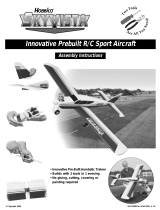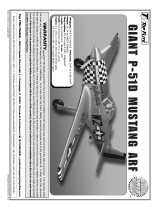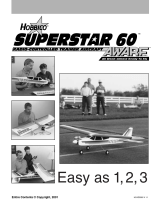Page is loading ...

Assemble the nose
Please carefully read instructions before assembling. Any errors in assembly may result in poor flying performance.
Choose a wide-open area with few people to fly the plane.
Do not launch the plane in the direction of other people.
Do not fly the plane near high-voltage electrical lines or crowds of people.
Sheet
material
210mm
170mm
155mm
3*3*160mm
Insert crank P2 from the nose of the plane
into the bottom of slot P1 as shown in the
diagram, with the bend kept vertical and
pointing downward.
*When dismantling A6, push
the bottom bracket of A6
outward.
Insert the bottom of slot A6 into the metal wire of the
nose, then push it horizontally into slot P1 in a
horizontal direction.
Once correctly assembled, P2 can shake smoothly.
As the diagram shows, attach A1 to the bend in crank P2 of
the airplane nose, then install A4 and A5 in that order.
As the diagram shows, insert A2 into the notch at the top of
P1, then attach connector head A1 to connector column A2.
Insert T4 into slot A2 and then attach A7 to the
other end. Insert T2 into the smaller slot at the
top of P1 and then attach A7 to the other end.
*After the nose of the plane is fully assembled, turn
the crank several times in a clockwise direction to
check whether the right and left arms can move up
and down symmetrically.
Rubber band
Panel A
Hole
Carbon fiber fuselage
Double-sided tape
Rubber Band Powered Ornithopter
*Pay attention to the direction
of the notch at the top of A1.
Hole
Smaller
hole
Installation

Stick the sheet
Final assembly
Fly Guide
First, use a moist towel to wipe the surface of the
table, then place the sheet material for the wings
and tail separately onto the tabletop with the
unprinted side facing up.
*Stick one end of the double-sided
tape to the tabletop.
As the diagram shows, cut a length of double-sided tape slightly longer than
the wing (the surplus length is used to secure the wing to the table during
assembly). Peel off one side of the tape covering and stick it to the unprinted
side of the sheet material along the sides and middle of the wings and tail.
Open the fully-assembled unit of the
nose of the plane, and affix the three
carbon fiber struts to their corresponding
strips of double-sided tape, starting with T2 strut and
then T4 struts, using moderate pressure to ensure they
are securely stuck together.
Insert T3 carbon fiber struts into their
corresponding holes in P3 and attach
A7 to the outer ends. Insert copper
chip P4 into the slot at the other end
of P3, then attach the assembled unit
to the tail sheet.
*Ensure that the protruding part
of the copper plate faces down.
Insert one end of T1 into the square slot at the bottom of P1, then fold the tail upward about 15
degrees. Twist the rubber band 9 times and hook it onto the front and plane rear, with the
knotted end at the tail.
*You can add A3 as needed to adjust the weight of the plane (read the fly guide for details).
*Attach A3 units separately as
needed to adjust different weights.
Hold A5 and turn the crank clockwise
about 50 times.
Let go with your left hand and wait for
the wings to begin flapping, then gently
throw the airplane forward with your
right hand.
You can adjust the climbing angle of the plane by
bending the tail higher or lower. The flight path
can be changed by adding A3 to the ends of the
struts or adjusting their positions.
Gently bend
How to tie the knot
Rubber band
Moist towel
Even tabletop
Double-sided tape
Double-sided tape
Unprinted side
Unprinted side
Peel away covering
Please keep this instruction, which has important information.
15°
Finished!
/




